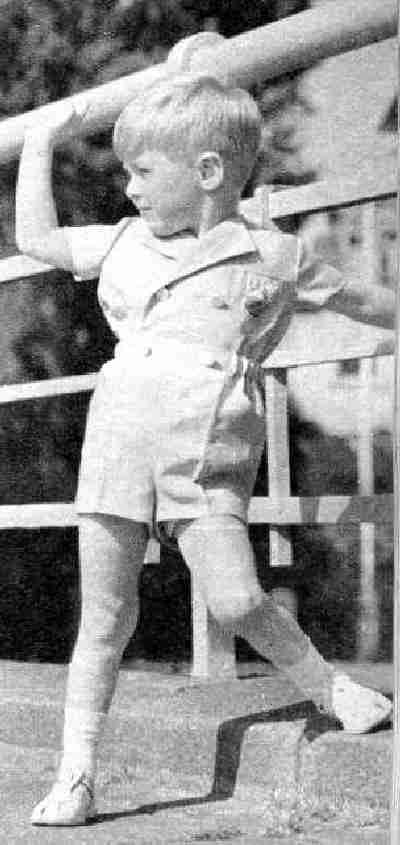
Dutch Boys' Clothes: Suits--20th Century Younger Styles

Figure 1.--This Dutch boy in 1960 wears a dressy button-on shorts set. He looks to be about 4 years old. The shirt is styled rather like a double breasted blazer--note the styilized badge. These dressy suits often had some casual elements--in this case an open collar. Also notice the elastizied back waist and ankle socks and sandals.
One HBC reader believes that the hair cut is reminiscent of John-John
Kennedy or Prince Charles. The white sandals and anklets make me think
this picture was taken for some formal event.
|
A variety of specialized suit styles have appeared for younger boys. These were esentially shorts sets, but not ones designed for play. The styles here have been quite varied, bit often employ style elements of the suits worn by older boys such as double breasted styling. These short suits have included suts with jackets as well as one-piece or button on pants--usually shorts. These were generally styles for pre-school boys, but some boys wore them for dress occassions for a few years after beginning school. Even those these were dressy outfits, they might have casual elements like open collars.
19th Century Styles
These juvenile-styled suits were not worn in the 19th century or even in the early 20th century before World War I (1914-18). Younger
boys in the 19th century were more likely to wear dresses or skirted garmets like various jacketed skirt outfits. American boys wore kilt suits, but I am unsure if this fashion was popular in the Netherlands. Some might wear fancy suits like Fauntleroy suits, both with skirts or kneepants. After the turn of the century tunic outfits were popular.
Button-on Outfits
Button-on outfits were usually blouses which button on to pants. Jackets were not normally involved, but some had blouses that were styled like jackets. These outfits were usually made with shorts, but longpants were no unknown. Some of the button on styles had front and back buttons. Some of the shorts had elastic backs. This added a more casual aspect to the outfit and also allows for the outfit to be worn longer as the boy grew.
Jacket Styles
A variety of specialized suit styles have appeared for younger boys. These were esentially shorts sets, but not ones designed for play. The styles here have been quite varied, bit often employ style elements of the suits worn by older boys such as double breasted styling. Even those these were dressy outfits, they might have casual elements like open collars.
Pants Styles
These younger suit outfits were made with varying types of pants.
Kneepants
These outfits were not commonly made with kneeapnts were seen as a garment for older boys and because many of these outfits developed after kneepants became less common.
Suits and other dressy outfits with rompers bottoms were popular for younger boys. In some cases a rather plain romper could be turned into a dressy one by adding a formal blouse. Dutch mothers muight dress
the boy in a blouse with a Peter Pan collar and puff sleeves for a very dressy look. A bow tie might even be added. Other dressy rompers had tops of various style from jacket-like garments to short smocks. The romper tops were usually quite short so that the romper bottom was not covered. The tops were commpinly worn with white Peter Pan collars. Often the collar was pinned onto the top and not part of a seoparate
blouse. The dressy rompers appear to have been worn from about the 1930s through the 1960s. They were generally worn by pre-school boys. Velvet was a popular material for the dressy rompers.
Short pants
Most of these suits for younger boys were made with short pants. This was the case through the 1970s and they countinue to be quite common.
Knickers
These suits were not normally made with knickers as these were considered to be a pants style for an older boy.
Long pants
Until the 1960s these outfits for younger boys were normally made with shorts, but HBC begins noring long pants outfits as well in the 1960s.
Ages
These were generally styles for pre-school boys, especially the romper suits. Some boys wore the shorts suits for dress occassins for a few years after beginning school.
Accompanying Garments
These outfits were commonly worn with both short socks and kneesocks. Sandals and strap shoes were also popular for younger boys with some of these dressy outfits.
Material
Velvet was a popular material for some of the dressier outfits. Knitwear was popular for younger boys and outfits were made with matching tops and bottoms--these were, however, more commonly casual than dressy outfits.
Christopher Wagner

Navigate the Boys' Historical Clothing Web Site:
[Introduction]
[Activities]
[Bibliographies]
[Biographies]
[Chronology]
[Clothing styles]
[Contributions]
[Countries]
[Boys' Clothing Home]
Navigate the Boys' Historical Clothing Dutch pages:
[Return to the Main Dutch suit page]
[Maiken Island]
[Dutch choirs]
[Dutch royalty]
[Dutch scouts]
[Dutch school uniform]
[Dutch boys bangs]
Navigate the Boys' Historical Clothing national pages:
[Return to the Main countries page]
[Australia]
[Belgium]
[England]
[France]
[Germany]
[Ireland]
[Italy]
[Japan]
[Korea]
[Mexico]
[Netherlands]
[Scotland]
[United States]
Created: April 23, 2001
Last updated: April 24, 2001



